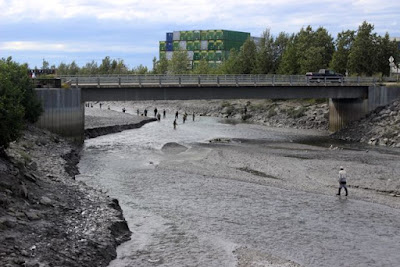The traffic wasn't moving on Benson as I was heading to the elections office to turn in to registrations and ask some questions about PFD registration and registering homeless folks.
I got onto Benson at Spenard and the left lane wasn't moving shortly after that. The two right lanes were empty. Here I was at Benson and C after the light's been red a while.
The two left lanes weren't moving because the folks in the right lanes were merging because at A street they were completely blocked off. My lane had a dying flare in it, so basically everyone had to move over to the far left lane.
At A Street and Benson, the problem was revealed. I'm guessing someone ran a red light, just can't tell which one.
I think I waited about four or five extra red lights, maybe fifteen extra minutes. This is just normal conditions in lots of parts of LA.
At the elections office I learned
Yes, when you register for the Alaska Permanent Fund Dividend (PFD) check, you're automatically registered. Some people, they told me, complained because they had no choice. She did refer me to the Elections website which has
a PDF updated August 2018, which answers all my questions.
I guess this is the key question, all the others, clarify this one:
"Why is the Division of Elections sending me mail?
The law requires the Division of Elections to send each PFD applicant that is eligible to vote an opt-out mailer giving the applicant/voter the option to opt-out of being automatically registered to vote or have their voter registration record updated."
I take this to mean that everyone who applies gets a letter from the Division of Elections, either to opt out, change information (namely address), or do nothing. If I got such a notice, I've totally forgotten it. If you do nothing, and you're already registered, everything stays the same. If you aren't registered and do nothing, you get registered to vote.
I'd note that in October 2016, when the initiative to add automatic PFD registration was coming before the voters in November,
Paul Jenkins had an opinion piece saying it was a waste of money, that people already had lots of ways to register if they wanted to. But then his real opposition to the initiative is revealed when he writes near the end:
"To argue the initiative is not about advancing Democrat fortunes at our expense is nonsensical. If the left wants to register voters it should pick up the check and not pass it on to a cash-strapped state while pretending it is for the civic good."
I would have to do some more research to see if his predictions that more Democrats will be signed up is true. I suspect that would be hard to determine since people are automatically registered as "undeclared." They would have to opt to change their party registration and I'm guessing most won't.
My guess is that Republicans wouldn't have any problem with spending money on this if they thought it would add Republican voters.
The Hill cites a recent Brennan Center report:
"Nine southern states previously had to get approval from the Department of Justice to change voting policies under a provision in the 1965 Voting Rights Act, but the Supreme Court struck down that measure in 2013.
“Across the board, formerly covered jurisdictions increased their purge rates after 2012 more than noncovered jurisdictions,” the report found.
The center highlighted Texas, Georgia and Virginia as states impacted by the 2013 Supreme Court ruling with higher rates of voter purging."
Actually there were 16 states overall that had to get preclearance from the Department of Justice before the Supreme Court ruling and Alaska was one of them.
But with the PFD registration (more people get PFD's than drivers licenses) Alaska has to be one of the most aggressive states actually getting people onto the rolls instead of off.
And it's nice to live in a state that's making it as easy as possible for people to register to vote. Unlike states where they are now aggressively purging the roles.
I'm curious what this means for voter registrars. How many people aren't registered. Of the two I registered last Friday, one had moved from out of state, so he clearly hadn't registered yet. But the other seemed to be someone who would have gotten a PFD check last year. But they checked and he wasn't registered. And, of course, all the people turning 18 before the election.
Homeless Registration?
People can use Bean's Cafe, or any other place they regularly eat at as their address. If they are living in a homeless camp off the bike trail through the woods, they can give the closest intersection or whatever description that will allow the elections office to determine what district they are in. Of course that won't work too well for mail-in only elections. But you can still go and vote early at various locations.






















































